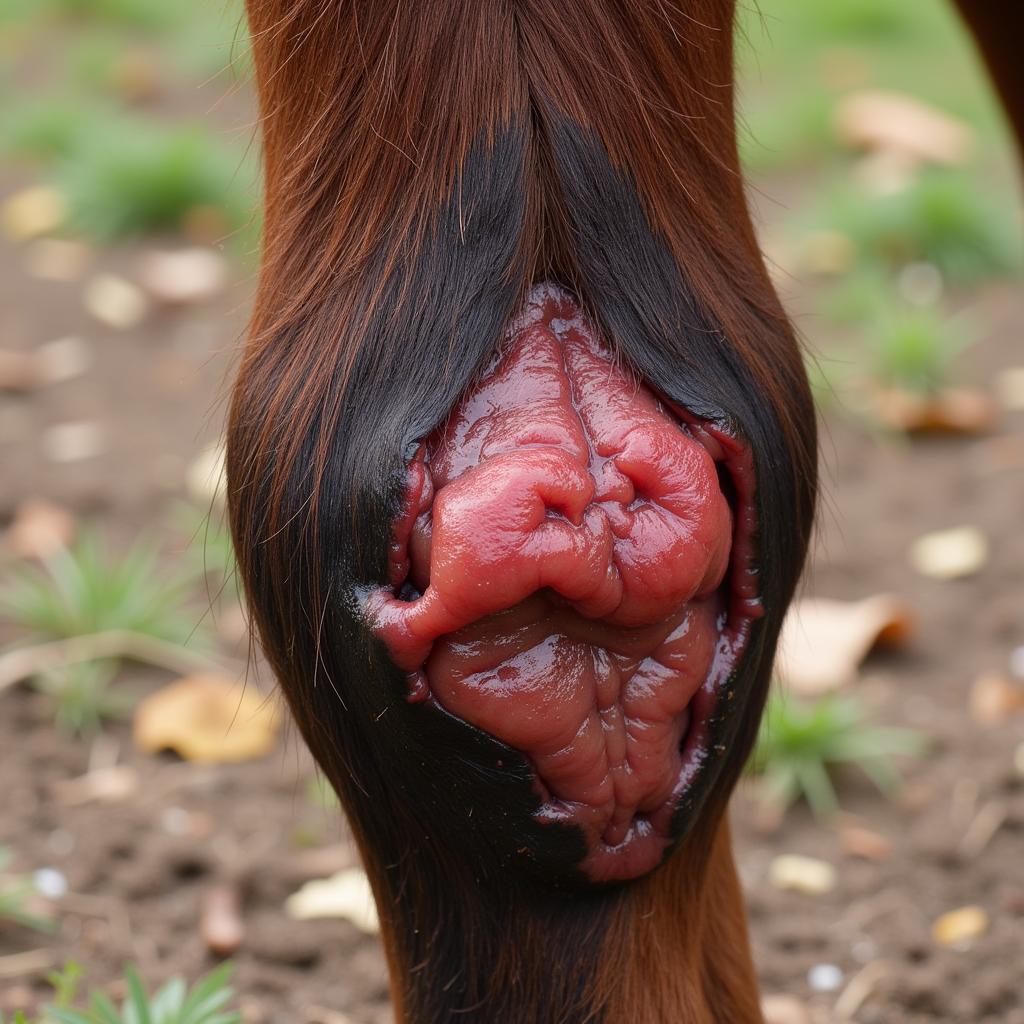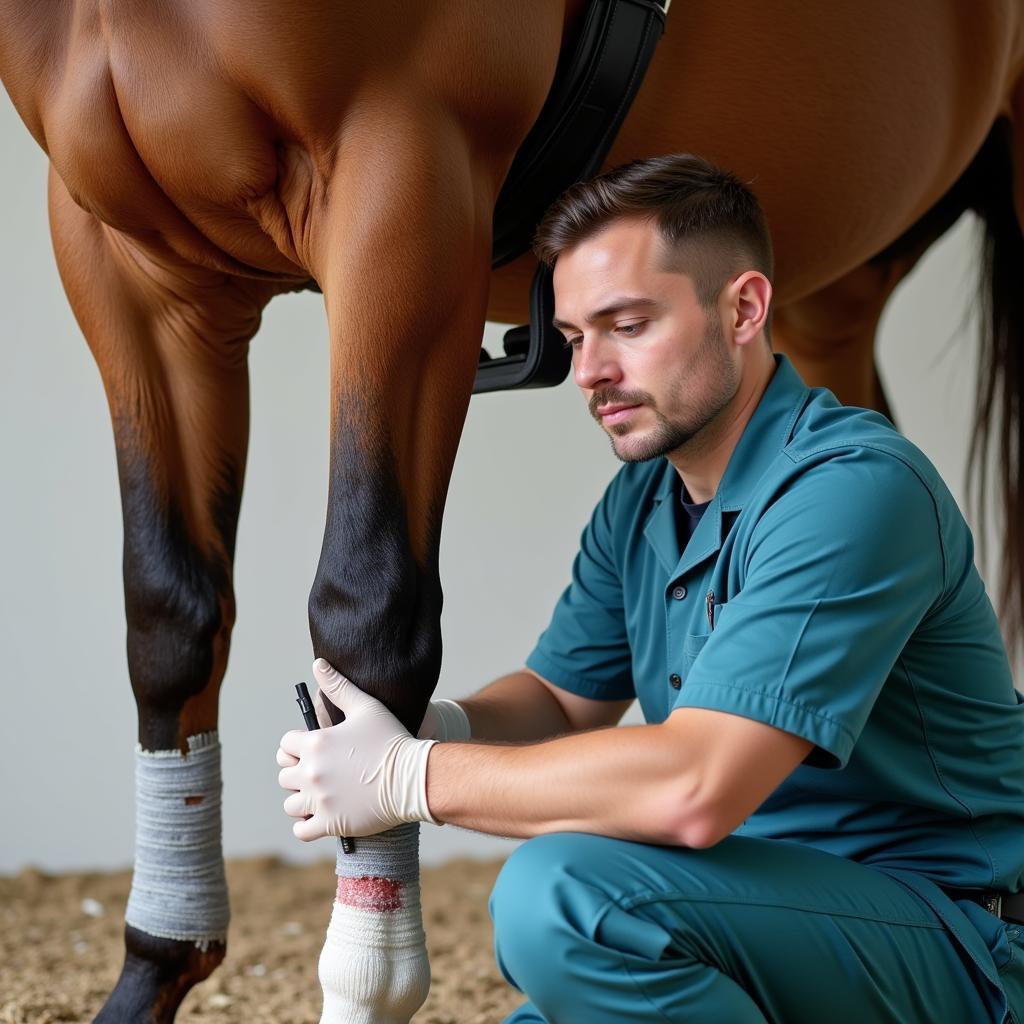Staph Infection In Horses, a common bacterial skin disease, can range from minor irritations to serious, life-threatening conditions. Understanding the causes, symptoms, and treatment options is crucial for every horse owner. This guide provides a comprehensive overview of staph infections in horses, equipping you with the knowledge to protect your equine companion.
What is a Staph Infection in Horses?
Staph infections are caused by bacteria belonging to the Staphylococcus genus, particularly Staphylococcus aureus. These bacteria are commonly found on the skin and in the nasal passages of horses, often without causing any harm. However, when the skin’s protective barrier is compromised – through cuts, abrasions, insect bites, or other injuries – these bacteria can invade and cause infection.
Different Types of Staph Infections in Horses
Staph infections in horses manifest in various forms, including:
- Infected wounds: The most common form, characterized by redness, swelling, pain, and pus discharge.
- Abscesses: Localized pockets of pus that form under the skin.
- Cellulitis: A diffuse infection of the skin and underlying tissues.
- Impetigo: A contagious skin infection characterized by crusty sores.
- Septicemia (blood poisoning): A rare but severe complication of staph infection.
Identifying the Symptoms of Staph Infection
Recognizing the signs of a staph infection is essential for early intervention. Common symptoms include:
- Redness and swelling around the affected area
- Heat radiating from the infected site
- Pain or tenderness to the touch
- Pus-filled sores or abscesses
- Crusty or scabby skin lesions
- Lethargy and loss of appetite (in severe cases)
 Staph Infection in a Horse Wound
Staph Infection in a Horse Wound
Diagnosing Staph Infection in Horses
A veterinarian will diagnose a staph infection based on the horse’s clinical signs and a bacterial culture. The culture identifies the specific bacteria causing the infection and helps determine the appropriate antibiotic treatment.
Importance of Veterinary Diagnosis
While some mild staph infections may resolve on their own, it’s crucial to seek veterinary care for any suspected infection. A veterinarian can accurately diagnose the condition and prescribe the appropriate treatment, preventing potential complications.
Treating Staph Infection: Options and Considerations
Treatment typically involves antibiotics, either topical or systemic, depending on the severity of the infection. In some cases, surgical drainage of abscesses may be necessary.
Topical Treatments for Staph Infection
Topical treatments, like antibiotic ointments or washes, are often effective for localized, superficial infections.
Systemic Antibiotics for More Severe Cases
Systemic antibiotics, administered orally or intravenously, are necessary for more widespread or severe infections.
 Horse Receiving Veterinary Care for Staph Infection
Horse Receiving Veterinary Care for Staph Infection
Preventing Staph Infections: Best Practices for Horse Owners
Maintaining good hygiene and promptly treating any wounds or injuries are key to preventing staph infections. Here are some preventive measures:
- Clean and disinfect wounds: Thoroughly clean any cuts or abrasions with antiseptic solution.
- Keep the environment clean: Regularly clean stalls, paddocks, and equipment.
- Isolate infected horses: Separate infected horses from healthy ones to prevent the spread of infection.
- Boost the horse’s immune system: Provide a balanced diet and adequate rest to support a healthy immune system.
- Regularly inspect your horse: Check for any signs of skin irritation or injury.
Dealing with Recurrent Staph Infections
Some horses are prone to recurrent staph infections. In such cases, a veterinarian may recommend further investigation to identify underlying causes, such as allergies or immune deficiencies.
“Regularly cleaning and disinfecting your horse’s environment, especially shared water troughs and grooming tools, can significantly reduce the risk of staph infections,” advises Dr. Emily Carter, DVM, a renowned equine veterinarian with over 20 years of experience. “Early intervention is key, so contact your vet immediately if you notice any signs of infection.”
 Healthy Horse in a Clean Stable
Healthy Horse in a Clean Stable
Conclusion: Protecting Your Horse from Staph Infection
Staph infection in horses is a common concern, but with proper care and management, it can be effectively treated and prevented. By understanding the causes, symptoms, and treatment options, you can take proactive steps to protect your equine companion from this bacterial skin disease. Regular veterinary checkups and maintaining a clean environment are essential for early detection and prevention of staph infections.
FAQ
- What is the most common cause of staph infection in horses? Breaks in the skin, like cuts and abrasions, allow the bacteria to enter and cause infection.
- Can staph infections be contagious between horses? Yes, staph infections can spread between horses through direct contact or contaminated surfaces.
- How long does it take for a staph infection to heal in a horse? Healing time varies depending on the severity of the infection and the horse’s overall health, typically ranging from a few weeks to several months.
- Can humans get staph infections from horses? While rare, it’s possible for humans to contract staph infections from horses, especially if they have open wounds or compromised immune systems.
- What is MRSA, and should I be concerned about it in my horse? MRSA (Methicillin-resistant Staphylococcus aureus) is a strain of staph bacteria resistant to certain antibiotics. It’s a serious concern in both horses and humans, requiring specific treatment protocols.
- How can I prevent staph infections in my horse’s stable? Regularly disinfecting stalls, water troughs, and grooming tools can help minimize the risk of infection.
- What should I do if I suspect my horse has a staph infection? Contact your veterinarian immediately for diagnosis and treatment.
For any assistance or further information, please contact us at Phone Number: 0772127271, Email: [email protected] or visit us at QGM2+WX2, Vị Trung, Vị Thuỷ, Hậu Giang, Việt Nam. We have a 24/7 customer service team.